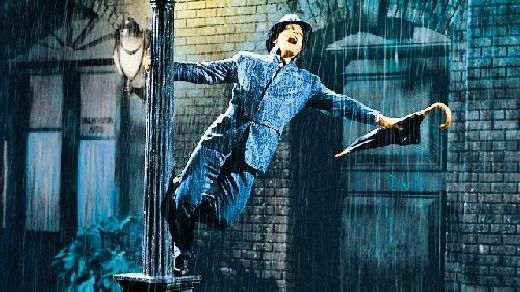Singin’ in the Rain (1952) 
“MGM’s Musical Treasure!”

Director: Stanley Donen, Gene Kelly
Cast: Gene Kelly, Donald O’Connor, Debbie Reynolds
Synopsis: A silent film production company and cast make a difficult transition to sound.
There are some films that everyone has heard of, regardless of their knowledge of movies, and Stanley Donen’s Singin’ in the Rain is one of them. The scenes in which leading man Gene Kelly capers and dances with infectiously joyous exuberance on a rain-swept street are instantly recognisable, and although the title song was at least 20 years old when Singin’ in the Rain was made, and had already featured in a host of other Hollywood films, today it is associated solely with this movie. The film was a hastily produced cash-in on the success of Kelly’s previous movie, An American in Paris, which had just won an Oscar; Kelly was reportedly a tyrannical, unpleasant man to work with, and he had a fever when he filmed that title song sequence, but sometimes things just click and movie history is made.
Perhaps what sustains Singin’ in the Rain’s reputation, in addition to a host of instantly recognisable songs, is the strength of the storyline. Most musicals have a plot which is simply there to fill the gaps between the numbers, and while most of Singin’ in the Rain’s running time is filled with musical numbers it still manages to include a solid storyline revolving around Hollywood’s troubled transition from silent pictures to talkies.
Kelly plays Don Lockwood, a major Hollywood star who has made a string of pictures with the beautiful – but dim – Lina Lamont (Jean Hagen). The fans think the pair are an item, as does Lina — because she read so in a movie magazine — but Lockwood loves Kathy Selden (Debbie Reynolds), a chorus girl still trying to make it in Hollywood. Following the smash hit success of The Jazz Singer, the studio head of Monumental Pictures decides that Lockwood and Lamont’s next movie, The Duelling Cavalier, will be all-talking. However, he doesn’t allow for Lina’s screechy Bronx accent or her inability to talk directly into the concealed microphones when performing. After a disastrous sneak preview of the movie, Lockwood decides, with the help of his friend Cosmo (Donald O’Connor) and Kathy, to transform it into a musical with Kathy dubbing for Lina.
Although I can appreciate that Singin’ in the Rain is a well-made movie, and arguably the best of its genre, I’ve never been a fan of the musical, and as the years go by the Hollywood musicals of the 1940s and 50s begin to look more and more antiquated. While musicals remain popular on the stage they’ve mostly fallen out of favour with moviegoers, and the few that are made today incorporate the songs into the storyline as a tangible component rather than have ordinary people spontaneously burst into song for no apparent reason. Singin’ in the Rain has its fair share of these moments, and while the songs might be tuneful, the sight of three people grinning inanely at one another as they crouch with hands on knees and perkily chirp ‘Good Morning’ to one another looks exactly like what it is: an obsolete form of entertainment from an age which has long since had its day.
But then, we shouldn’t lightly dismiss the work that the entertainers involved undoubtedly put into these movies. Donald O’Connor, a four-pack-a-day man, was bedridden for three days after performing the ‘Make ‘em Laugh’ number, and suffered carpet burns (don’t snigger), and the sheer athleticism of the dance numbers is quite astonishing. Just watch those running-off-the-wall back-flips O’Connor performs and notice how much speed and power he has to generate to stop himself from simply crashing to the ground. Get it wrong and he could quite easily have snapped his neck. And look at those simple spins Kelly performs during the Broadway Melody number: they look simple, but try performing a couple yourself — then try to explain to your boss how you did your back in when you phone in sick…
All in all then, Singin’ in the Rain is the cinematic equivalent of a valuable antique that no longer possesses any useful function, but which can be gazed upon with a certain amount of pleasure and appreciation simply for its beauty and the quality of the workmanship that went into making it.
(Reviewed 29th November 2012)
httpv://www.youtube.com/watch?v=D1ZYhVpdXbQ
